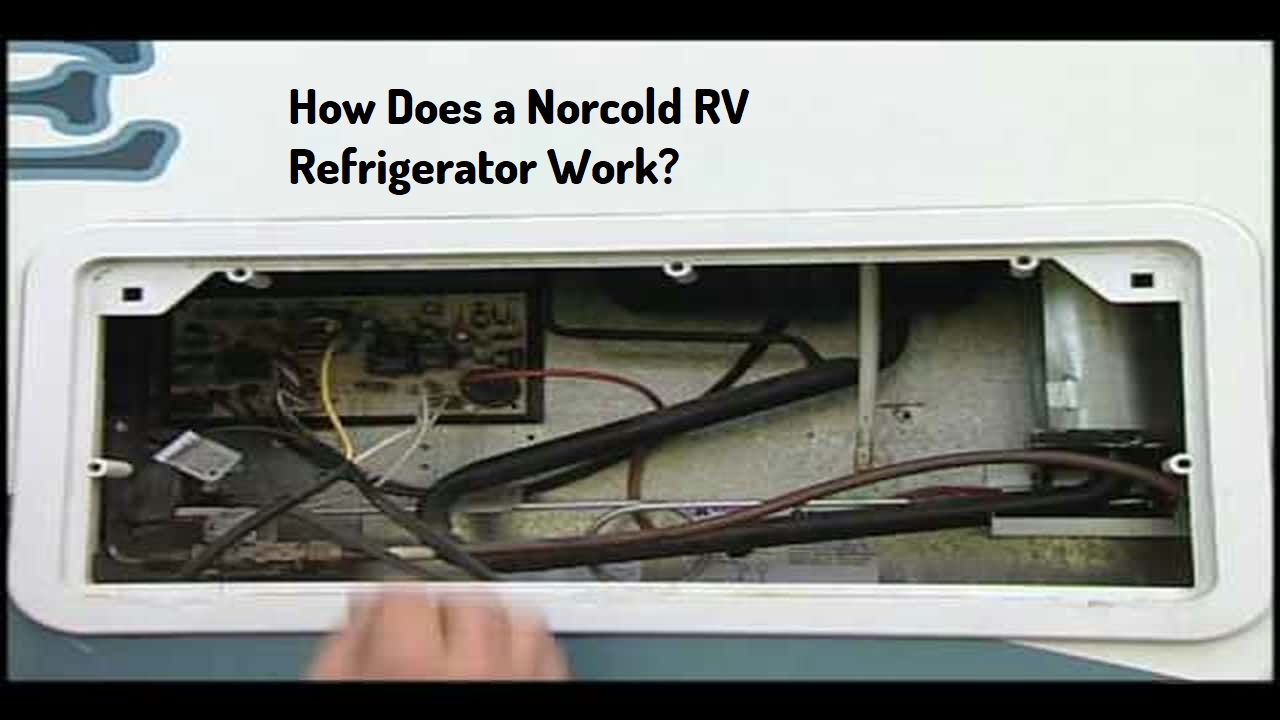Greetings, fellow RV enthusiasts and seekers of cool wonders! Embarking on the road with your RV means embracing the marvels of mobile living, and at the heart of it all is the fascinating technology that keeps your food and beverages cool.
I’m Poli, your guide from Your Camping Assistant, and today, let’s unravel the science behind the question: How does a Norcold RV refrigerator work?
A Norcold RV refrigerator cools using a combination of a compressor, coils, and refrigerant. The compressor circulates the refrigerant to absorb and release heat to keep the interior cold.
An essential component of any RV, a Norcold refrigerator, operates similarly to a standard home fridge but is designed to handle the challenges of mobile living. This type of refrigerator keeps food and beverages cold while the RV is in motion, ensuring that travelling occupants can access fresh and chilled items.
Scroll down to more.
The Components Of A Norcold RV Refrigerator
The Components of a Norcold RV Refrigerator are essential to understand for proper maintenance and troubleshooting. Whether you’re an avid RVer or a newcomer to the lifestyle, knowing the workings of your refrigerator can help you address issues and keep your RV living comfortable and convenient.
Cooling Unit
The cooling unit of a Norcold RV refrigerator is a key component responsible for maintaining the internal temperature. It operates on absorption refrigeration, using a combination of hydrogen gas, ammonia, and water to remove heat and create cool temperatures inside the refrigerator.
This continuous process effectively keeps your food and beverages fresh during your travels.
Controls And Features
Norcold RV refrigerators come equipped with convenient and user-friendly controls and features. These include adjustable temperature settings, interior lighting, and storage options designed to optimize the available space.
The controls allow you to customize the refrigerator’s performance according to your specific needs, ensuring your supplies remain properly chilled throughout your RV adventures.
Power Source
The power source for a Norcold RV refrigerator can vary depending on the model. Typically, these refrigerators can run on either electricity, propane, or both.
This versatility ensures you can keep your food cold regardless of your RV’s power source, making it a reliable appliance for all camping and travelling situations.

Credit: www.ebay.com
The Cooling Process
Understanding how a Norcold RV refrigerator works involves delving into the cooling process. The cooling process utilizes an absorption refrigeration cycle powered by heat and cooling.
Let’s break it down into two key aspects:
Absorption Refrigeration Cycle
The absorption refrigeration cycle is the heart of a Norcold RV refrigerator’s operation. Unlike traditional compressor-based refrigeration, which relies on mechanical compression, absorption refrigeration utilizes a chemical process involving heat, pressure, and refrigerant.
This cycle consists of four essential components – the evaporator, the absorber, the condenser, and the generator. When the refrigerator is turned on, the ammonia-based refrigerant mixture begins its journey through these components, resulting in a continuous cycle that promotes cooling.
- The evaporator: Captures the heat inside the refrigerator, causing the ammonia-based refrigerant mixture to evaporate and absorb the heat from the stored items.
- The absorber: Absorbs the ammonia vapor produced by the evaporator and assists in separating it from the hydrogen gas.
- The condenser: Releases the heat absorbed from the evaporator to the outside of the refrigerator by condensing the ammonia vapor into a liquid form.
- The generator: Reheats the ammonia liquid from the condenser, causing it to evaporate again, and restarting the absorption refrigeration cycle.
Heat Source And Cooling
To power the absorption refrigeration cycle, a heat source is required. In the case of a Norcold RV refrigerator, the three common heat sources are electricity, propane, and battery power. This flexibility allows RV owners to keep their food cold while on the road, regardless of the availability of a specific power source.
When an external heat source, such as propane or electricity, is utilized, it heats the generator, which in turn initiates the cycle by providing the necessary heat to evaporate the ammonia liquid. As a result, the evaporator cools down, effectively chilling the entire refrigerator interior.
On the other hand, battery power can also be used as a heat source in an RV refrigerator, providing an alternative option for cooling. This feature ensures that even when electricity or propane is not available, the refrigerator can still maintain a low temperature.
Understanding the cooling process of a Norcold RV refrigerator enables you to maximize its functionality and ensure the freshness of your stored food items while on your road trips. With its absorption refrigeration cycle and various heat sources, this refrigerator offers reliable cooling performance, catering to the diverse needs of RV owners.
Troubleshooting And Maintenance
Proper troubleshooting and regular maintenance for your Norcold RV refrigerator are vital to ensure its optimal performance. By being aware of common issues and following maintenance tips, you can prevent potential problems and extend the lifespan of your fridge.
Common Issues
When it comes to Norcold RV refrigerators, there are several common issues you may encounter. However, by understanding these problems, you can effectively troubleshoot and resolve them to keep your refrigerator running smoothly. Some common issues include:
- Failure to cool properly
- Excessive frosting or ice buildup
- Frequent power failures or irregular power supply
- Strange noises or vibrations
- Leakage of water or refrigerant
Maintenance Tips
Regular maintenance is key to preventing issues with your Norcold RV refrigerator. By following these simple maintenance tips, you can ensure the longevity of your fridge and avoid unnecessary repair expenses:
- Keep the refrigerator clean and free from food debris to prevent mold and bacteria growth.
- Regularly check and clean the condenser coils to maintain proper cooling efficiency.
- Ensure proper ventilation around the refrigerator to prevent overheating.
- Regularly inspect the door gasket for any signs of wear and tear, and replace if necessary to maintain an airtight seal.
- Level your RV to ensure the refrigerator operates correctly and avoids any cooling issues.
- Check the propane supply and ensure the refrigerator is operating on the correct power source.
- Refer to the manufacturer’s manual for any specific maintenance requirements and follow accordingly.

Credit: www.amazon.com
Safety Precautions And Best Practices
When using a Norcold RV refrigerator, it’s crucial to prioritize safety to prevent accidents and ensure the smooth functioning of the appliance. By following these safety precautions and best practices, you can have peace of mind while enjoying the convenience of an efficient and reliable refrigerator on your RV adventures.
Proper Ventilation
To guarantee optimal performance and prevent potential hazards, it’s essential to provide proper ventilation for your Norcold RV refrigerator. This allows for efficient cooling and prevents the build-up of potentially hazardous gases.
The ventilation system of your RV refrigerator consists of intake and exhaust vents. These vents need to be clear of any obstructions such as debris, plants, or other objects that might impede the airflow. Regularly clean and inspect the vents to ensure adequate ventilation.
Here are some best practices for properly venting your Norcold RV refrigerator:
- Make sure to follow the manufacturer’s guidelines on vent placement and size.
- Keep at least one-inch clearance on all sides of the vents to promote airflow.
- Avoid parking your RV in direct sunlight or near heat sources, as excessive heat can affect the refrigerator’s cooling capacity.
Handling Propane
Propane is a common fuel source for RV refrigerators, and it’s crucial to handle it with utmost caution. Here are some safety precautions to keep in mind when dealing with propane:
- Check for leaks by applying a soap and water solution to the connections. If you see bubbles forming, there might be a leak, and you should address it immediately.
- Only use and store propane cylinders in well-ventilated areas, away from any open flames or ignition sources.
- Turn off the propane supply before entering areas where it’s prohibited, such as gas stations or tunnels.
- Ensure the proper installation of propane lines and connections by a qualified professional.
Safe Operating Procedures
To keep your Norcold RV refrigerator operating safely and efficiently, it’s essential to follow these safe operating procedures:
- Regularly inspect the refrigerator for any signs of damage or malfunction. If you notice any issues, address them promptly to prevent further complications.
- Avoid overloading the refrigerator with food items. Overloading can restrict airflow and affect the cooling performance.
- When defrosting the freezer, follow the manufacturer’s guidelines and avoid using sharp objects that could damage the appliance.
- Keep the refrigerator level to ensure proper functioning. Use a leveling device to make necessary adjustments when parking your RV.
By adhering to these safety precautions and best practices, you can enjoy the convenience and reliability of your Norcold RV refrigerator while ensuring the safety of yourself and your fellow travelers on your RV journeys.

Credit: www.amazon.com
Frequently Asked Questions Of How Does A Norcold Rv Refrigerator Work
How Does A Norcold Rv Refrigerator Work?
A Norcold RV refrigerator works through a process called absorption. It utilizes heat to create a cooling effect. The refrigerator has a series of tubes and chambers containing a mixture of ammonia, hydrogen gas, and water. When heat is applied, the ammonia evaporates, travels through the system, and then condenses to cool the interior.
The process repeats to maintain the desired temperature inside the refrigerator.
Sum Up
To sum it up, a Norcold RV refrigerator uses electricity and propane gas to keep your food and beverages fresh while on the road. By understanding the basic principles behind its functioning, you can properly maintain and troubleshoot any issues that may arise.
So, whether you’re an RV enthusiast or a newbie, knowing how a Norcold RV refrigerator works is crucial for a seamless and enjoyable journey. Keep your fridge running smoothly, and happy travels.
See you later. Thanks
Poli,


